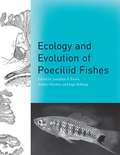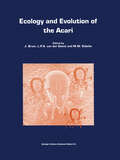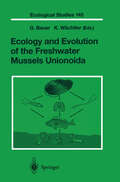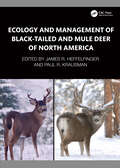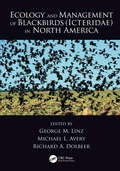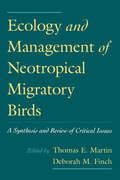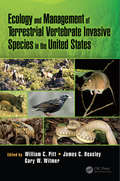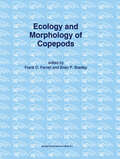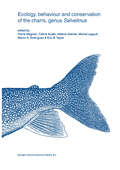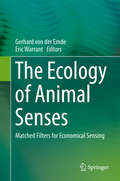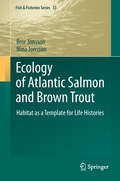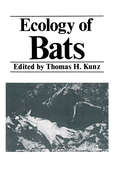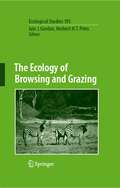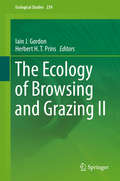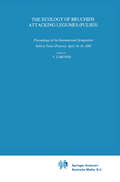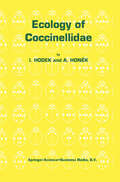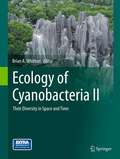- Table View
- List View
Ecology and Evolution of Poeciliid Fishes
by Jonathan P. EvansThe history of biology is populated by numerous model species or organisms. But few vertebrate groups have aided evolutionary and ecological research more than the live-bearing fishes of the family Poeciliidae. Found throughout tropical and subtropical waters, poeciliids exhibit a fascinating variety of reproductive specializations, including viviparity, matrotrophy, unisexual reproduction, and alternative mating strategies, making them ideal models for research on patterns and processes in ecology, behavior, and evolution. Ecology and Evolution of Poeciliid Fishes is a much-needed overview of the scientific potential and understanding of these live-bearing fishes. Chapters by leading researchers take up a wide range of topics, including the evolution of unisexual reproduction, life in extreme environments, life-history evolution, and genetics. Designed to provide a single and highly approachable reference, Ecology and Evolution of Poeciliid Fishes will appeal to students and specialists interested in all aspects of evolutionary ecology.
Ecology and Evolution of Poeciliid Fishes
by Jonathan P. Evans Andrea Pilastro Ingo SchluppThe history of biology is populated by numerous model species or organisms. But few vertebrate groups have aided evolutionary and ecological research more than the live-bearing fishes of the family Poeciliidae. Found throughout tropical and subtropical waters, poeciliids exhibit a fascinating variety of reproductive specializations, including viviparity, matrotrophy, unisexual reproduction, and alternative mating strategies, making them ideal models for research on patterns and processes in ecology, behavior, and evolution. Ecology and Evolution of Poeciliid Fishes is a much-needed overview of the scientific potential and understanding of these live-bearing fishes. Chapters by leading researchers take up a wide range of topics, including the evolution of unisexual reproduction, life in extreme environments, life-history evolution, and genetics. Designed to provide a single and highly approachable reference, Ecology and Evolution of Poeciliid Fishes will appeal to students and specialists interested in all aspects of evolutionary ecology.
Ecology and Evolution of the Acari: Proceedings of the 3rd Symposium of the European Association of Acarologists 1–5 July 1996, Amsterdam, The Netherlands (Series Entomologica #55)
by J. Bruin Leo P. S. Van Der Geest M. W. SabelisAcarology is on the move! The growing interest from evolutionary and molecular biologists and from population and community ecologists in mites and ticks has a strong impetus on the field of acarology. This book contains many chapters that illustrate the recent progress in the field.
Ecology and Evolution of the Freshwater Mussels Unionoida (Ecological Studies #145)
by KlausWächtler GerhardBauerAll those who think that bivalves are boring are in the best company. Karl von Frisch is reported to have turned the pages more quickly in texts where bivalves were treated because, according to him, they literally lack any behaviour. The fact that they can filtrate huge amounts of water, burrow into the sedi ment, actively swim, drill holes into rocks and boats or detect shadows with the aid of pretty blue eyes located on the rim of their mantle obviously left v. Frisch unimpressed. Why, then, a book on the large freshwater mussels (Naiads or Unionoida), which on first sight are much less spectacular than the marine ones? The main reason is that they are keepers of secrets which they reveal only on close and careful inspection. This is not only true for the pearls some species produce and which over centuries have contributed to the treasures of bishops and kings, but particularly for their ecology: their life cycles are linked with those of fishes, some can occur in incredible densities and some can live for more than 100 years. Thus, the presence or absence of naiads in a lake or stream has manifold implications.
Ecology and Management of Black-tailed and Mule Deer of North America
by James R. Heffelfinger and Paul R. KrausmanBlack-tailed and mule deer represent one of the largest distributions of mammals in North America and are symbols of the wide-open American West. Each chapter in this book was authored by the world’s leading experts on that topic. Both editors, James R. Heffelfinger and Paul R. Krausman, are widely published in the popular and scientific press and recipients of the O. C. Wallmo Award, given every two years to a leading black-tailed and mule deer expert who has made significant contributions to the conservation of this species. In addition, Heffelfinger has chaired the Mule Deer Working Group sponsored by the Western Association of Fish and Wildlife Agencies for more than 15 years. This working group consists of the leading black-tailed and mule deer experts from each of 24 states, provinces, and territories in western North America, putting them at the forefront of all conservation and much of the research on this species. The book represents all current knowledge available on these deer, including how changing conditions such as fires, habitat alteration and loss, disease, climate change, socio-economic forces, energy development, and other aspects are influencing their distribution and abundance now and into the future. It takes a completely fresh look at all chapter topics. The revisions of distribution, taxonomy, evolution, behavior, and new and exciting work being done in deer nutrition, migration and movements, diseases, predation, and human dimensions are all assembled in this volume. This book will instantly become the foundation for the latest information and management strategies to be implemented on the ground by practitioners and to inform the public. Although this book is about deer, the topics discussed influence most terrestrial wildlife worldwide, and the basic concepts in many of the chapters are applicable to other species.
Ecology and Management of Black-tailed and Mule Deer of North America
Black-tailed and mule deer represent one of the largest distributions of mammals in North America and are symbols of the wide-open American West. Each chapter in this book was authored by the world’s leading experts on that topic. Both editors, James R. Heffelfinger and Paul R. Krausman, are widely published in the popular and scientific press and recipients of the O. C. Wallmo Award, given every two years to a leading black-tailed and mule deer expert who has made significant contributions to the conservation of this species. In addition, Heffelfinger has chaired the Mule Deer Working Group sponsored by the Western Association of Fish and Wildlife Agencies for more than 15 years. This working group consists of the leading black-tailed and mule deer experts from each of 24 states, provinces, and territories in western North America, putting them at the forefront of all conservation and much of the research on this species. The book represents all current knowledge available on these deer, including how changing conditions such as fires, habitat alteration and loss, disease, climate change, socio-economic forces, energy development, and other aspects are influencing their distribution and abundance now and into the future. It takes a completely fresh look at all chapter topics. The revisions of distribution, taxonomy, evolution, behavior, and new and exciting work being done in deer nutrition, migration and movements, diseases, predation, and human dimensions are all assembled in this volume. This book will instantly become the foundation for the latest information and management strategies to be implemented on the ground by practitioners and to inform the public. Although this book is about deer, the topics discussed influence most terrestrial wildlife worldwide, and the basic concepts in many of the chapters are applicable to other species.
Ecology and Management of Blackbirds (Icteridae) in North America
by George M. Linz Michael L. Avery Richard A. DolbeerShortlisted for the 2018 TWS Wildlife Publication Awards in the edited book category The various species of new world blackbirds, often intermingled in large foraging flocks and nighttime roosts, collectively number in the hundreds of millions and are a dominant component of the natural and agricultural avifauna in North America today. Because of their abundance, conspicuous flocking behavior, and feeding habits, these species have often been in conflict with human endeavors. The pioneering publications on blackbirds were by F. E. L. Beal in 1900 and A. A. Allen in 1914. These seminal treatises laid the foundation for more than 1,000 descriptive and experimental studies on the life histories of blackbirds as well as their ecology and management in relation to agricultural damage and other conflicts such as caused by large winter roosting congregations. The wealth of information generated in over a century of research is found in disparate outlets that include government reports, conference proceedings, peer-reviewed journals, monographs, and books. For the first time, Ecology and Management of Blackbirds (Icteridae) in North America summarizes and synthesizes this vast body of information on the biology and life histories of blackbirds and their conflicts with humans into a single volume for researchers, wildlife managers, agriculturists, disease biologists, ornithologists, policy makers, and the public. The book reviews the life histories of red-winged blackbirds, yellow-headed blackbirds, common grackles, and brown-headed cowbirds. It provides in-depth coverage of the functional roles of blackbirds in natural and agricultural ecosystems. In doing so, this authoritative reference promotes the development of improved science-based, integrated management strategies to address conflicts when resolutions are needed.
Ecology and Management of Blackbirds (Icteridae) in North America
by George M. Linz Michael L. Avery Richard A. DolbeerShortlisted for the 2018 TWS Wildlife Publication Awards in the edited book category The various species of new world blackbirds, often intermingled in large foraging flocks and nighttime roosts, collectively number in the hundreds of millions and are a dominant component of the natural and agricultural avifauna in North America today. Because of their abundance, conspicuous flocking behavior, and feeding habits, these species have often been in conflict with human endeavors. The pioneering publications on blackbirds were by F. E. L. Beal in 1900 and A. A. Allen in 1914. These seminal treatises laid the foundation for more than 1,000 descriptive and experimental studies on the life histories of blackbirds as well as their ecology and management in relation to agricultural damage and other conflicts such as caused by large winter roosting congregations. The wealth of information generated in over a century of research is found in disparate outlets that include government reports, conference proceedings, peer-reviewed journals, monographs, and books. For the first time, Ecology and Management of Blackbirds (Icteridae) in North America summarizes and synthesizes this vast body of information on the biology and life histories of blackbirds and their conflicts with humans into a single volume for researchers, wildlife managers, agriculturists, disease biologists, ornithologists, policy makers, and the public. The book reviews the life histories of red-winged blackbirds, yellow-headed blackbirds, common grackles, and brown-headed cowbirds. It provides in-depth coverage of the functional roles of blackbirds in natural and agricultural ecosystems. In doing so, this authoritative reference promotes the development of improved science-based, integrated management strategies to address conflicts when resolutions are needed.
Ecology and Management of Neotropical Migratory Birds: A Synthesis and Review of Critical Issues
by Thomas E. Martin Deborah M. FinchThe apparent decline in numbers among many species of migratory songbirds is a timely subject in conservation biology, particularly for ornithologists, ecologists, and wildlife managers. This book is an attempt to discuss the problem in full scope. It presents an ambitious, comprehensive assessment of the current status of neotropical migratory birds in the U.S., and the methods and strategies used to conserve migrant populations. Each chapter is an essay reviewing and assessing the trend from a different viewpoint, all written by leaders in the fields of ornithology, conservation, and population biology.
Ecology and Management of Terrestrial Vertebrate Invasive Species in the United States
by William C. Pitt James Beasley Gary W. WitmerVertebrate invasive species are important ecologically, socially, and scientifically throughout much of the globe. However, the interdiction and options for management of invasive species are driven by localized regulation at the country or even state level and thus the management of species must be framed within that context. This book is focused around the management of invasive vertebrate species in the United States, although readers will find much of the material broadly applicable to invasive species in other regions. Vertebrate invasive species cause damage to agriculture, property, natural resources, and threaten human health and safety. However, most of these species occur in the United States resulting from human-mediated activities, often being released intentionally. For the first time, the wealth of scientific information about vertebrate invasive species in the United States is summarized and synthesized in a single volume to be easily accessible to ecologists and natural resource managers. With a focus on prominent terrestrial invasive species that have a history of policy and management and highlighting contemporary issues and management, this book consists of 18 chapters written by experts from across the United States. The first section of the book focuses on overarching policy and management topics associated with vertebrate invasive species; including biosecurity threats and risk assessment, policy and regulation, and the economics of their management. The second section provides in-depth reviews of noteworthy invasive mammals, birds, amphibians, and reptiles. After finishing this book, the reader should understand the complexity of managing invasive species, the unique challenges that each new species may present, and the steps forward that may decrease the impact of these species on the environment, human health, and the economy.
Ecology and Management of Terrestrial Vertebrate Invasive Species in the United States
by William C. Pitt James Beasley Gary W. WitmerVertebrate invasive species are important ecologically, socially, and scientifically throughout much of the globe. However, the interdiction and options for management of invasive species are driven by localized regulation at the country or even state level and thus the management of species must be framed within that context. This book is focused around the management of invasive vertebrate species in the United States, although readers will find much of the material broadly applicable to invasive species in other regions. Vertebrate invasive species cause damage to agriculture, property, natural resources, and threaten human health and safety. However, most of these species occur in the United States resulting from human-mediated activities, often being released intentionally. For the first time, the wealth of scientific information about vertebrate invasive species in the United States is summarized and synthesized in a single volume to be easily accessible to ecologists and natural resource managers. With a focus on prominent terrestrial invasive species that have a history of policy and management and highlighting contemporary issues and management, this book consists of 18 chapters written by experts from across the United States. The first section of the book focuses on overarching policy and management topics associated with vertebrate invasive species; including biosecurity threats and risk assessment, policy and regulation, and the economics of their management. The second section provides in-depth reviews of noteworthy invasive mammals, birds, amphibians, and reptiles. After finishing this book, the reader should understand the complexity of managing invasive species, the unique challenges that each new species may present, and the steps forward that may decrease the impact of these species on the environment, human health, and the economy.
Ecology and Morphology of Copepods: Proceedings of the 5th International Conference on Copepoda, Baltimore, USA, June 6–13, 1993 (Developments in Hydrobiology #102)
by Frank D. Ferrari Brian P. BradleyEcology and Morphology of Copepods is organized under the following general topics: Behavior, Feeding, Genetics, Horizontal Variations, Morphology, Phylogeny, Reproduction, Seasonal Changes, Vertical Distribution, plus two special sessions on copepods of the genus Acartia and cyclopid/mosquito interactions. The Maxilliped Lecture, given by Dr. Arthur G. Humes of Boston University, clearly established the importance of copepods to the earth's organic diversity. The book consists of selected research articles from the different sections. The articles published here reflect the diverse research interests of copepodologists today, and are distinguished by their high quality. Their impact will ensure that this volume is consulted by a wide range of research biologists.
Ecology and Natural History of Desert Lizards: Analyses of the Ecological Niche and Community Structure
by Eric R. PiankaEric Pianka offers a synthesis of his life's work on the comparative ecology of lizard assemblages in the Great Basin. Mojave and Sonoran deserts of western North America, the Kalahari semi-desert of southern Africa, and the Great Victoria desert of Western Australia.Originally published in 1986.The Princeton Legacy Library uses the latest print-on-demand technology to again make available previously out-of-print books from the distinguished backlist of Princeton University Press. These editions preserve the original texts of these important books while presenting them in durable paperback and hardcover editions. The goal of the Princeton Legacy Library is to vastly increase access to the rich scholarly heritage found in the thousands of books published by Princeton University Press since its founding in 1905.
Ecology, behaviour and conservation of the charrs, genus Salvelinus (Developments in Environmental Biology of Fishes #22)
by Pierre Magnan Céline Audet Hélène Glémet Michel Legault Marco A. Rodríguez Eric B. TaylorSalvelinus species are one of the most thoroughly studied groups of fishes. Many reasons explain this intense interest in charr biology. Charrs have a Holarctic distribution encompassing many Asian, North American, and European countries and occupy diverse marine and freshwater environments. Furthermore, the current distribution of charr includes areas that were directly influenced by climate and topographic change associated with the many Pleistocene glaciations. Undoubtedly, these conditions have promoted much of the tremendous morphological, ecological, and genetic variability and plasticity within Salvelinus species and they make charr very good models to study evolutionary processes 'in action'. Many charr species also exhibit demographic characteristics such as slow growth, late maturity, and life in extreme environments, that may increase their susceptibility to extinction from habitat changes and overexploitation, especially in depauperate aquatic habitats. This vulnerability makes understanding their biology of great relevance to biodiversity and conservation. Finally, charr are of great cultural, commercial, and recreational significance to many communities, and their intimate linkage with human societies has stimulated much interest in this enigmatic genus. This volume comprises a selection of papers presented at the fourth International Charr Symposium held in Trois-Rivières (Québec, Canada), from 26 June to 1 July 2000. It includes 31 papers on ecological interactions and behaviour, trophic polymorphism, movement and migration, ecophysiology and evolutionary genetics, ecological parasitology, environmental stress and conservation. These studies cannot cover all recent developments in the ecology, behaviour and conservation of Salvelinus species, but collecting them into a special volume should bring attention to current research on this important genus and stimulate further work on Salvelinus species.
The Ecology of Animal Senses: Matched Filters for Economical Sensing
by Gerhard von der Emde Eric WarrantThe collection of chapters in this book present the concept of matched filters: response characteristics “matching” the characteristics of crucially important sensory inputs, which allows detection of vital sensory stimuli while sensory inputs not necessary for the survival of the animal tend to be filtered out, or sacrificed. The individual contributions discuss that the evolution of sensing systems resulted from the necessity to achieve the most efficient sensing of vital information at the lowest possible energetic cost. Matched filters are found in all senses including vision, hearing, olfaction, mechanoreception, electroreception and infrared sensing and different cases will be referred to in detail.
Ecology of Atlantic Salmon and Brown Trout: Habitat as a template for life histories (Fish & Fisheries Series #33)
by Bror Jonsson Nina JonssonDestruction of habitat is the major cause for loss of biodiversity including variation in life history and habitat ecology. Each species and population adapts to its environment, adaptations visible in morphology, ecology, behaviour, physiology and genetics. Here, the authors present the population ecology of Atlantic salmon and brown trout and how it is influenced by the environment in terms of growth, migration, spawning and recruitment. Salmonids appeared as freshwater fish some 50 million years ago. Atlantic salmon and brown trout evolved in the Atlantic basin, Atlantic salmon in North America and Europe, brown trout in Europe, Northern Africa and Western Asia. The species live in small streams as well as large rivers, lakes, estuaries, coastal seas and oceans, with brown trout better adapted to small streams and less well adapted to feeding in the ocean than Atlantic salmon. Smolt and adult sizes and longevity are constrained by habitat conditions of populations spawning in small streams. Feeding, wintering and spawning opportunities influence migratory versus resident lifestyles, while the growth rate influences egg size and number, age at maturity, reproductive success and longevity. Further, early experiences influence later performance. For instance, juvenile behaviour influences adult homing, competition for spawning habitat, partner finding and predator avoidance. The abundance of wild Atlantic salmon populations has declined in recent years; climate change and escaped farmed salmon are major threats. The climate influences through changes in temperature and flow, while escaped farmed salmon do so through ecological competition, interbreeding and the spreading of contagious diseases. The authors pinpoint essential problems and offer suggestions as to how they can be reduced. In this context, population enhancement, habitat restoration and management are also discussed. The text closes with a presentation of what the authors view as major scientific challenges in ecological research on these species.
Ecology of Bats
by T. H. KunzAmong living vertebrates bats and birds are unique in their ability to fly, and it is this common feature that sets them apart ecologically from other groups. Bats are in some ways the noctumal equivalents of birds, having evolved and radiated into a diversity of forms to fill many of the same niches. The evolution of flight and echolocation in bats was undoubtedly a prime mover in the diversification of feeding and roosting habits, reproductive strategies, and social behaviors. Bats have successfully colonized almost every continential region on earth (except Antarctica), as weIl as many oceanic islands and archipelagos. They comprise the second largest order of mammals (next to rodents) in number of species and probably exceed all other such groups in overall abundance. Bats exhibit a dietary diversity (including insects, fruits, leaves, flowers, nectar and pollen, fish. other vertebrates, and blood) unparalleled among other living mammals. Their reproductive pattems range from seasonal monestry to polyestry, and mating systems inelude promiscuity, monogamy, and polygyny. The vast majority of what we know about the ecology of bats is derived from studies of only a few of the approximately 850 species, yet in the past two decades studies on bats have escalated to a level where many important empirical pattems and processes have been identified. This knowledge has strengthened our understanding of ecological relationships and encouraged hypothesis testing rather than perpetuated a catalog of miscellaneous observations.
The Ecology of Browsing and Grazing (Ecological Studies #195)
by Iain J. Gordon Herbert H. T. PrinsThis volume investigates how large herbivores not only influence the structure and distribution of the vegetation, but also affect nutrient flows and the responses of associated fauna. The mechanisms and processes underlying the herbivores' behavior, distribution, movement and direct impact on the vegetation are discussed in detail. It is shown that an understanding of plant/animal interactions can inform the management of large herbivores to integrate production and conservation in terrestrial systems.
The Ecology of Browsing and Grazing II (Ecological Studies #239)
by Iain J. Gordon Herbert H. T. PrinsDomestic and wild large mammalian herbivores occur on every continent except Antarctica. Through their browsing and grazing, they affect the structure and distribution not only of vegetation, but also of associated fauna. Consequently, the interactions between management practices and herbivore populations influence the biodiversity, structure and dynamics of ecosystems across vast expanses around the globe: signs of human activity that will be detectable for epochs to come. As a follow-up work to The Ecology of Browsing and Grazing, published in 2008, this new volume presents cutting-edge research on the behaviour, distribution, movement, and direct and indirect impacts of domestic and wild herbivores on terrestrial ecosystems. The respective chapters highlight strategic and applied research on cross-cutting issues in palaeontology and ecology, and provide concrete recommendations on the management of large herbivores to integrate production and conservation in terrestrial systems. Given its scope, the book will appeal to students, researchers and anyone interested in understanding these fascinating wild animals and how they shape the natural world.
The Ecology of Bruchids Attacking Legumes: Proceedings of the International Symposium held at Tours (France), April 16–19, 1980 (Series Entomologica #19)
by V. LabeyrieAs editor of this volume I am not going to emphasize the economic im portance of the Bruchids of pulses, nor how necessary it is to know the conditions of infestation of crops in order to achieve an efficient protection; both points are testified by F.A.O.'s sponsorship, as well as of the International Organization for Biological Control. On the other hand I would like to stress the scientific interest of the study of 'domestic' bruchids. It raises questions which require that present basic entomological knowledge be extended. I am not going to review all questions raised but I will emphasize those I am most aware of. Some bruchid species have been able to colonize habitats differing totally; some differing in their latitude, and thus their basic periodicities; others differing in their degree of complexity (stocks of seeds): What are the respective roles played by polymorphism and plasticity in that exceptional capacity? What differences are there between the populations living on wild plants in dispersal areas and those living in stocks? What are the alterations brought about by the drastic selection pressures in populations having later colonized habitats ecologically similar to the original habitats? What factors determine the degree of specificity of trophic relationships, and the possibilities of extension of the niche? What influences are exerted by the other elements of the original bio cenoses upon the behavioural evolution of these species? Such are a few fundamental problems that can be tackled directly through
Ecology of Coccinellidae (Series Entomologica #54)
by Ivo Hodek Alois HonekCoccinellids have been very actively studied in the course of the twenty three years since "Biology of Coccinellidae" was published. The great amount of new, and often very important findings have made the previous book outdated and a new synthesis is needed. No other monograph of similar focus and extent has appeared. Iablokoff Khnzorian's "Les Coccinelles" (1982), limited to the tribus Coccinellini, and Gor don's "The Coccinellidae of America North of Mexico" (1985) both concentrate on taxonomy. Majerus' beautiful "Ladybirds" (1994) deal specifically with British coc cinellids and address chiefly amateur naturalists. The focus and the title of the recent book are slightly different from the 1973 vol ume. If a satisfactory comprehensive review of important new findings is attempted, the book would grow too much, due also to References and Indexes. To keep the vol ume at a tolerable extent, the section on larval identification of Palaearctic species has been omitted; not much could be added to the previous version of that part, any way. However, we have kept Kovar's chapter on morphology and anatomy, because of its relation to feeding and other ecological aspects. The chapter on phylogeny was updated also by him. Our Polish friend, Piotr Ceryngier, who has recently specialised in parasites, updated perfectly the parts on parasites and pathogens in Chapter 8. We would be glad if their contribution is quoted by their names. It seems to us that the remarks, contained in the reprinted preface to the previous volume, remain pertinent today.
The Ecology of Collective Behavior
by Deborah M. GordonA groundbreaking new perspective on collective behavior across biological systemsCollective behavior is everywhere in nature, from gene transcription and cancer cells to ant colonies and human societies. It operates without central control, using local interactions among participants to allow groups to adjust to changing conditions. The Ecology of Collective Behavior brings together ideas from evolutionary biology, network science, and dynamical systems to present an ecological approach to understanding how the interactions of individuals generate collective outcomes.Deborah Gordon argues that the starting point for explaining how collective behavior works in any natural system is to consider how it changes in relation to the changing world around it. She shows how feedback use—the means by which networks of interactions operate—and the organization of interaction networks evolve to reflect the stability and demands of the environment. Ant colonies function collectively, and the enormous diversity of species in different habitats provides opportunities to look for general ecological patterns. Through an in-depth comparison of ant species, Gordon identifies broad trends in how the diversity of collective behavior in many other collective systems reflects the dynamics of the environment.Shedding light on how individual actions give rise to group behavior, The Ecology of Collective Behavior explains the evolution of collective behavior through innovation in participant interactions, offering new insights into how collective responses function in changing conditions.
The Ecology of Collective Behavior
by Deborah M. GordonA groundbreaking new perspective on collective behavior across biological systemsCollective behavior is everywhere in nature, from gene transcription and cancer cells to ant colonies and human societies. It operates without central control, using local interactions among participants to allow groups to adjust to changing conditions. The Ecology of Collective Behavior brings together ideas from evolutionary biology, network science, and dynamical systems to present an ecological approach to understanding how the interactions of individuals generate collective outcomes.Deborah Gordon argues that the starting point for explaining how collective behavior works in any natural system is to consider how it changes in relation to the changing world around it. She shows how feedback use—the means by which networks of interactions operate—and the organization of interaction networks evolve to reflect the stability and demands of the environment. Ant colonies function collectively, and the enormous diversity of species in different habitats provides opportunities to look for general ecological patterns. Through an in-depth comparison of ant species, Gordon identifies broad trends in how the diversity of collective behavior in many other collective systems reflects the dynamics of the environment.Shedding light on how individual actions give rise to group behavior, The Ecology of Collective Behavior explains the evolution of collective behavior through innovation in participant interactions, offering new insights into how collective responses function in changing conditions.
Ecology of Cyanobacteria II: Their Diversity in Space and Time
by Brian A. WhittonCyanobacteria have existed for 3.5 billion years, yet they are still the most important photosynthetic organisms on the planet for cycling carbon and nitrogen. The ecosystems where they have key roles range from the warmer oceans to many Antarctic sites. They also include dense nuisance growths in nutrient-rich lakes and nitrogen-fixers which aid the fertility of rice-fields and many soils, especially the biological soil crusts of arid regions. Molecular biology has in recent years provided major advances in our understanding of cyanobacterial ecology. Perhaps for more than any other group of organisms, it is possible to see how the ecology, physiology, biochemistry, ultrastructure and molecular biology interact. This all helps to deal with practical problems such as the control of nuisance blooms and the use of cyanobacterial inocula to manage semi-desert soils. Large-scale culture of several organisms, especially "Spirulina" (Arthrospira), for health food and specialist products is increasingly being expanded for a much wider range of uses. In view of their probable contribution to past oil deposits, much attention is currently focused on their potential as a source of biofuel.Please visit http://extras.springer.com/ to view Extra Materials belonging to this volume.This book complements the highly successful Ecology of Cyanobacteria and integrates the discoveries of the past twelve years with the older literature.
Ecology Of Forest Insects (Series Entomologica #26)
by A. SzujeckiFew branches of the biological sciences have developed to such an extent as has ecology in the recent decades. The successful development of this science is directly related to need to create a sound scientific basis by which we can control our diminishing natural resources and integrate this with the control of biological systems of the component species. Studies on the bioenergetics of ecosystems, as well as on the home ostatic mechanisms functioning at the populations and biocenoses levels are of great importance in this respect. The results of these studies are very significant in forestry management which deals with multiannual tree communities - forest stands. It is particularly important in this of the necessity for the possible respect for economic planning, in view prolonged maintenance of forest biocenoses as stable systems. Neither in the present nor in the immediate future can be protection of forest ecosystems consisting of natural plant and animal communities be achieved by the cultivation of resistant forms or the intensification of chemical intervention.
